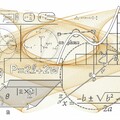Peter Somogyi received the Semmelweis-Budapest Prize 2012
Peter Somogyi, Unit Director, received the Semmelweis-Budapest Prize 2012 and delivered his lecture “Co-operative chronocircuits in the hippocampus of the brain” at the Hungarian Academy of Sciences on the 22nd November 2012.
He has dedicated the 10,000 Euro prize to the setting up of the Stephen W. Kuffler Scholarship Foundation.
Prof. Péter Somogyi's talk on his scientific work that led to the Brain Prize award. Grete Lundbeck European Brain Research Foundation hosted the annual Brain Prize Meeting at Hindsgavl Castle
Source: http://www.biologictube.dk
Péter Somogyi’s fundamental and pioneering work on the chemical identification of neuronal types and localization of signalling molecules in identified microcircuits is a key pillar of contemporary neuroscience. Péter Somogyi has pioneered the identification of individual neurons by defining their synaptic relationships, molecular composition, synaptic effects and temporal dynamics recorded both in vitro and in vivo. He discovered and defined many neurons and their place in synaptic circuits of the neocortex, the hippocampus, the cerebellum and the basal ganglia.
Péter Somogyi's work has led to the molecular dissection of synaptic junctions through the quantitative, high-resolution electron microscopic localization of neurotransmitter receptors; he discovered the perisynaptic domain as a specific molecular assembly and the pre- and postsynaptic compartmentalization of distinct receptor types in or outside the synaptic junction. His long-term vision that explanations of normal and pathological events in the brain can only come from the rigorous definition of the neuronal circuits has become widely recognized. Somogyi has delineated a basic cortical circuit from molecular composition through cell types to the dynamic behaviour of neuronal networks. Many of the approaches that he introduced to neuroscience have been adopted widely. His pupils lead institutions and research programmes around the world. Outstanding scientists in the interdisciplinary Anatomical Neuropharmacology Unit that he leads apply his approaches to different systems affected in diseases of the brain. Recently, he and his colleagues discovered an unsuspected temporal division of labour amongst inhibitory interneurons in the hippocampal formation and on the way recognised several novel cell types. In general, Somogyi’s work has demonstrated how a co-operative division of labour in time and space between distinct identified neurons underlies the processing power of the cortex. Somogyi’s conceptual framework and multidisciplinary approaches to the study of the cerebral cortex leads to explanations of chronocircuitry, a term he coined to reflect the unity of time and space in the brain.

Connections from GABAergic cells to principal cells
Peter Somogyi: Co-operation in science and neuronal societies of the brain
Nervous systems evolved to enable animals to move and interact with the external and internal environments. Interactions take place on various time scales reflected in the temporal pattern of neuronal activity. Adaptations that deliver optimal interactions in time to the requirements of the environment drive evolution of the nervous system and are reflected in the properties of molecules, synapses and cells that we observe and measure. “There is grandeur in this view of life.... Whilst this planet has gone cycling on according to the fixed law of gravity, from so simple a beginning, forms most beautiful and most wonderful have been and are being evolved” wrote Charles Darwin. We observe these wonderful forms in the arborisation patterns of neuronal processes in space, which connect nerve cells. The delivery a given function of the brain requires the co-ordinated activity of
different kinds of neuron, many still to be discovered and understood. The complex representations underlying particular memories, percepts and actions are thought to be encoded by the synchronous activity of particular subpopulations of neurons, known as cell assemblies. It is ironic that so far we have failed to account for the variety of nerve cells that build our cerebral cortex, which is the structure responsible for all our conscious experience, culture and scientific endeavour, and the majority of neurological and psychiatric disorders. Perhaps, capturing the differentiation in the temporal activity of cortical neurons during behaviourally relevant activity helps defining cell types and the mechanism of their contribution to the organism in health and disease.
Understanding the brain requires co-operation amongst specialists, as reflected in the Brain Prize, because the challenges are beyond the capacity of any individual mind. In my lecture, I will explore the principles outlined above in the highly ordered neuronal circuits of the hippocampus, a part of the cerebral cortex responsible for encoding, consolidating and the recall of episodic memories in the mammalian brain. In the cortical network, accurately timed and located synaptic activity co-operates in the information-carrying connections of pyramidal cells that release the amino acid glutamate as messenger. The spike timing and firing rate of pyramidal cells, which form the majority of neurons in the cortex, is responsible for the formation and storage of representations of the world. Space and time in the network forms an indivisible unity of evolutionary design. In the hippocampus, a relatively uniform population of pyramidal cells and their inputs follow an instantly recognisable laminated
pattern and act within network oscillations of activity that we measure as brain waves. Pyramidal cell assemblies form during learning and chains of assemblies represent temporal sequences of events in the life of the organism. The setting up of the robust and reproducible network oscillations, which are necessary for the formation of cell assemblies, is achieved by the co-operative activity of the second smaller populations of neurons, which inhibit the pyramidal cells in strictly defined time windows and provide accuracy to their activity. Just as in animal societies, including our own, the different players in the neuronal network have specialised jobs and interact co-operatively, as a neuronal machine. Defining the players, understanding and explaining their interactions leads to insights into neuronal events of the brain in health and disease.
*
Curriculum Vitae
Peter Somogyi graduated in biology and received his Ph.D. in cell biology at the Eötvös Loránd University, Budapest, Hungary. His research training included neurocytology with Istvan Benedeczky and neuroanatomy with Janos Szentagothai at the Semmelweis Medical School, Budapest; biochemistry with A. David Smith and Ian Chubb at the University of Oxford, and immunocytochemistry with Claudio Cuello at Oxford and a postdoctoral fellowship with Ian Chubb at Flinders Medical Centre, South Australia.
He has been training research students since 1978. In 1985 he was invited to become Associate, later Co-Director of the Medical Research Council Anatomical Neuropharmacology Unit at the University Department of Pharmacology, Oxford. He became Director from October 1998.
Awards:
- 1976 & 1977: First Prize of the Hungarian Academy of Sciences for Junior Scientists.
- 1982: M. Lenhossek Prize of the Association of Hungarian Anatomists and Embryologists
- 1984: Charles Judson Herrick Award of the Association of American Anatomists
- 1990 Honorary Doctorate, Jozsef Attila University, Szeged, Hungary
- 1991 Krieg Cortical Discoverer Award of the Cajal Club, American Anatomical Society
- 1995 Yngve Zotterman Prize, Physiological Society, Stockholm, Sweden
- 1996 Professor of Neurobiology, Oxford University
- 1998 Distinguished Visiting Professor, Kyoto University
- 2002 Visiting Professor, National Institute of Physiological Sciences, Okazaki, Japan
- 2004 Elected Nicholas Kurti Senior Research Fellow, Brasenose College, Oxford
- 2006 Janos Arany Medal, Hungarian Academy of Sciences, Presidential Committee for contribution to Hungarian science from abroad
- 2006 Istvan Bathory Award from the Hungarian National Council of Transylvania for working on restoring Hungarian higher education in Romania
- 2008 Elected Associate, Neuroscience Research Program, The Neurosciences Institute, San Diego
- 2009 The Feldberg Prize and Lectures, Feldberg Foundation, London, UK
- 2010 Honorary Guest Professor at the Medical University of Vienna, Austria
- 2010 The Palay Award, Journal of Comparative Neurology and the Cajal Club, San Diego, USA
- 2011 The Brain Prize, Grete Lundbeck European Brain Research Foundation, Copenhagen
Named and Honorary Lectures
- 1990 Moruzzi Lecture, European Neuroscience Association, Stockholm
- 1995 Julian Tobias Memorial Lecture, University of Chicago
- 2001 Jerzy Olszewski Lecture, Montreal Neurological Institute, Canada
- 2002 Janos Szentagothai Memorial Lecture, Hungarian Academy of Sciences, Hungary
- 2003 Wenner-Gren Distinguished Lecturer, Sweden 2003 Segerfalk Award Lecture, University of Lund, Sweden
- 2004 Special Plenary Lecture, 16th IFAA Conference, Kyoto, Japan
- 2005 1st Janos Szentagothai Memorial Lecture, University of California, Irvine, USA
- 2006 Quastel Lecure, Otto Loewi Conference, Eilat, Israel
- 2006 Servier Conference Lecture, Neuroscience Research Centre, University of Montreal
- 2008 The IBRO Lecture, Univ. Debrecen, Hungary
- 2008 The 1st Hans Kosterlitz Lecture, University of Aberdeen, Scotland
Membership of learned societies:
- 2000 elected Fellow of The Royal Society of London.
- 2004 elected a Corresponding Member of the Hungarian Academy of Sciences.
- 2006 elected Fellow of The Academy of Medical Sciences, London.
- 2006 elected Member of the German National (Leopoldina) Academy.
- 2009 elected Member of the Academia Europaea.
Anatomical Neuropharmacology Unit

University of Oxford Anatomical Neuropharmacology Unit
Forrás: http://www.mrc.ox.ac.uk/
Somogyi Group
Objectives
The overall aim is to define how the activity of neuronal assemblies is co-ordinated and emerges from the co-operative interactions of rigorously defined neuronal circuits in the cerebral cortex. Specific circuits are defined and dissected in terms of their constituent cell types, functional synaptic relationships and molecular machinery mediating the interactions. The role of selected interactions is established in the functional behaviour of the cortical network. Based on the knowledge gained about the molecular composition and connections of identified neurones, specific cell types are targeted in transgenic animals using a novel strategy for the selective modulation of their activity. This could lead to the determination of their functional contribution to the cortical network. The results explain cortical operations and identify links for the treatment of disease.
Methodology
Combined functional and structural analysis of neuronal interactions is carried out. Whole cell patch clamp recordings are carried out in vitro from single neurones and from several neurones simultaneously to test their interactions. The same types of cells are also recorded in vivo during behaviour contingent network oscillations. The characterisation of synaptic interactions is achieved using drugs acting on neurotransmitter receptors and ion channels. The recorded cells are labelled and analysed using light and electron microscopic techniques, including immunocytochemistry. The quantitative evaluation of receptors in relation to transmitter release sites is achieved by quantitative electron microscopic immunogold procedures.

Striatal Medium Spiny Neuron
Source: http://www.mrc.ox.ac.uk/







